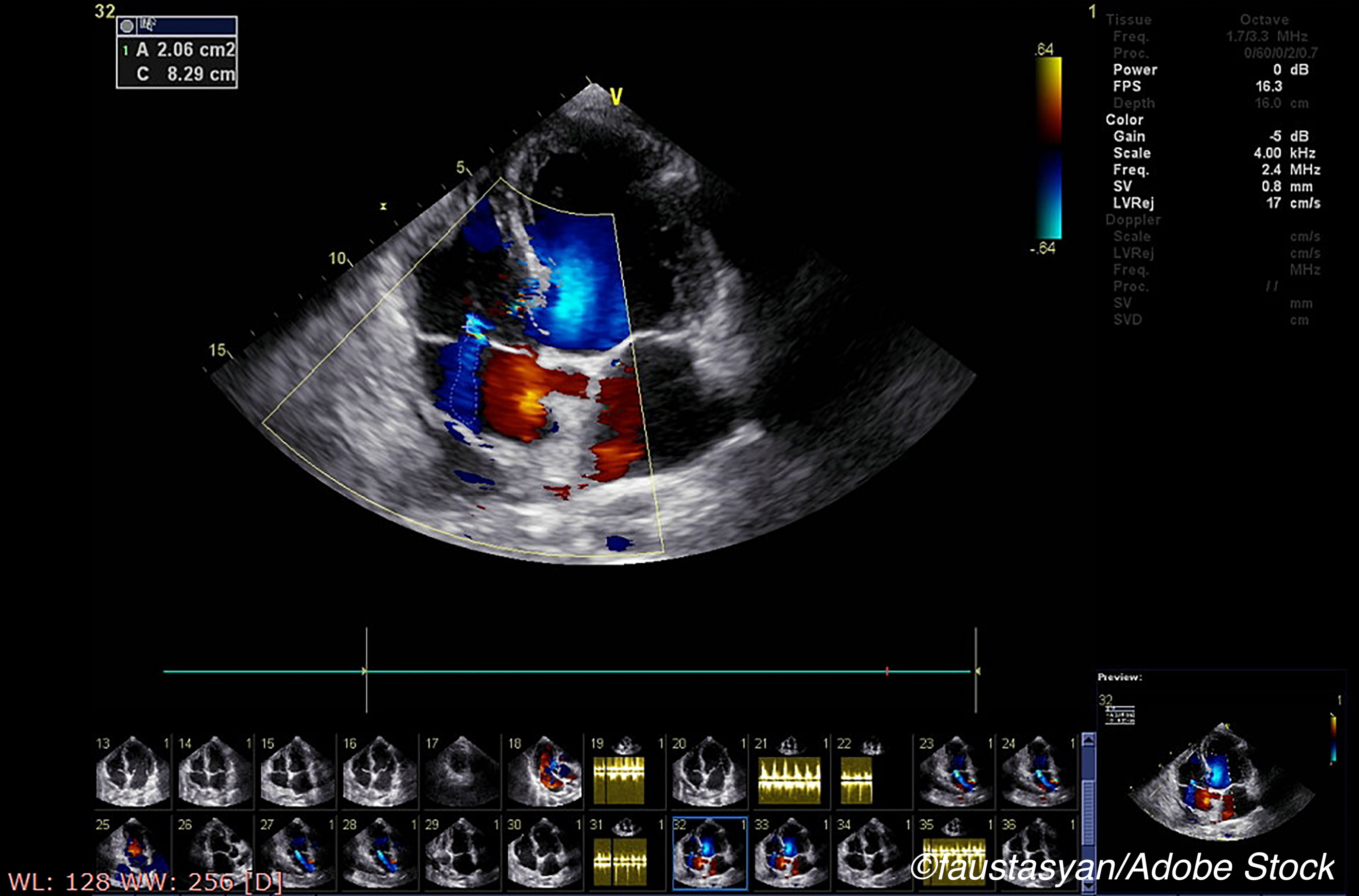When sacubitril/valsartan was tested in persons with preserved ejection fraction heart failure (HFpEF) in the PARAGON-HF trial, the initial results were disappointing: sacubitril/valsartan did not reduce the rate of heart failure hospitalizations nor did it reduce cardiovascular mortality compared to valsartan monotherapy. But the initial results were not the last word, as a series of post-hoc analyses drilled down looking for signals of benefits.
For example, Jonathan W. Cunningham, MD, of Brigham and Women’s Hospital in Boston and colleagues, reported in the Journal of the American College of Cardiology that sacubitril/valsartan appears to alter circulating biomarkers — N-terminal propeptide of collagen I and III, tissue inhibitor of matrix metalloproteinase 1, carboxyl-terminal telopeptide of collagen type I, and soluble ST2 — which signaled a beneficial change in extracellular matrix homeostasis.
The bottom line? The sacubitril/valsartan combination may reduce profibrotic signaling which may “play a role in the pathophysiology of HFpEF,” they wrote.
“Higher baseline levels of sST2 and TIMP-1 and increases in these markers over time were associated with greater risk of HF hospitalization and CV death,” thy added. “Sacubitril/valsartan altered these biomarkers in a pattern that suggests a decrease in profibrotic signaling. All of these findings were independent of sex and EF. In aggregate, these data suggest that biomarkers reflecting ECM homeostasis are elevated in HFpEF, altered by sacubitril/valsartan, and have important prognostic value.”
In an editorial that accompanied the study, a trio of researchers from Spain, Antoni Bayes-Genis, MD, PhD, Julio Núñez, MD, PhD, and Josep Lupón, MD, PhD, suggested that sacubitril/valsartan as an antifibrotic drug may “rejuvanate” the fibrosed, failing heart of patients with HFpEF.
“Cunningham, et al should be commended for executing this elegant study and providing new evidence of the antifibrotic benefit of sacubitril/valsartan in HFpEF, which complements the remarkable reverse remodeling data recently reported by the PROVE-HF (Effects of Sacubitril/Valsartan Therapy on Biomarkers, Myocardial Remodeling, and Outcomes) study in patients with HFrEF,” they wrote. “In summary, the rejuvenating antifibrotic effects of sacubitril/valsartan are great news for patients experiencing HFpEF, an orphan of proven therapeutics.”
The enthusiasm of Bayes-Genis, Núñez, and Lupón does, however, require some caution, since all three disclosed receiving lecture fees from Novartis, which sponsored the PARAGON-HF trial.
Cunningham and colleagues measured baseline levels of N-terminal propeptide of collagen I and III, tissue inhibitor of matrix metalloproteinase 1, carboxyl-terminal telopeptide of collagen type I, and soluble ST2 in 1,135 participants in the PARAGON-HF study. Levels were measured again at 16 weeks in 1,113 participants and at 48 weeks in 1,016 participants.
The baseline values of biomarkers of all study participants were compared with “published values of these biomarkers from referent control subjects.”
Their analysis compared the effects of sacubitril/valsartan on the biomarkers versus the effect of valsartan alone. “Baseline biomarker values and changes from baseline to 16 weeks were related to primary endpoint,” they wrote.
Interestingly, the baseline levels of all 5 biomarkers “were higher than published referent control values.”
Among the findings at 16 weeks:
- Among sacubitril/valsartan patients, tissue inhibitor of matrix metalloproteinage 1 decreased by 8% compared to valsartan-treated patients (95% confidence interval [CI]: 6% to 10%; P < 0.001).
- Among sacubitril/valsartan patients, soluble ST2 decreased by 4% versus the valsartan group (95% CI: 1%-%; P = 0.002).
- Among sacubitril/valsartan patients, N-terminal propeptide of collagen III decreased by 3% versus valsartan patients (95% CI: 0%-6%; P = 0.04).
- Among sacubibril/valsartan patients, carboxyl-terminal telopeptide of collagen type I by increased 4% compared to valsartan patients (95% CI: 1%-8%; P = 0.02).
The findings were consistent in both men and women and among those with left ventricular ejection fraction above or below 57%.
“Higher levels of tissue inhibitor of matrix metalloproteinase 1 and soluble ST2 at baseline and increases in these markers at 16 weeks were associated with higher primary endpoint event rates,” they wrote.
Cunningham and colleagues noted that “to our knowledge, this is the first study to demonstrate this relationship in patients with HFpEF. The relationships between higher levels of sST2 and TIMP-1 (and increases in these markers) and greater risk of CV death and HF hospitalization remained statistically significant even after robust multivariable adjustment for all baseline covariates including NT-proBNP and hsTNT.”
The observed changes in biomarker levels with sacubitril/valsartan “compared with valsartan alone would be predicted to reflect significant changes in ECM [extracellular matrix] homeostasis,” they wrote. “TIMP-1 inhibits a number of MMPs, thus inhibiting the catabolism of insoluble fibrillar collagen and promoting its accumulation. In PARAGON-HF and PARADIGM-HF, treatment with sacubitril/valsartan decreased TIMP-1; therefore sacubitril/valsartan may alter ECM homeostasis in a manner that may reduce profibrotic signaling.”
Nonetheless, the findings are limited because the baseline biomarker values were compared with those of referent control subjects from previous publications, not with those of patients enrolled contemporaneously as part of PARAGON-HF.”
Finally, they concluded that the patients enrolled in the PARAGON-HF trial had “had elevated levels of circulating biomarkers reflecting abnormal ECM homeostasis. Baseline biomarker levels and short-term changes were associated with subsequent risk of HF events independently of clinical risk factors. Sacubitril/valsartan significantly altered these biomarkers. These data suggest that interstitial myocardial fibrosis contributes to HFpEF pathogenesis and prognosis and that antifibrotic properties may contribute to the mechanism of potential benefit of sacubitril/valsartan in patients with HFpEF.”
-
Be aware that this analysis is based on data from patients enrolled in the PARAGON-HF trial — patients who had elevated baseline levels of the extracellular matrix biomarkers analyzed in this study.
-
Note that treatment with sacubitril/valsartan was associated with reductions in biomarkers of perturbed ECM homeostasis. Those reductions were associated with improved clinical outcomes in HFpEF.
Peggy Peck, Editor-in-Chief, BreakingMED™
PARAGON-HF was sponsored by Novartis.
Cunningham received a National Heart, Lung and Blood Institute grant.
PARAGON-HF co-principal investigator John J. V.McMurray, MD, has consulted for Bayer, Cardiorentis, Amgen, Theracos, AbbVie, DalCor, Pfizer, Merck, AstraZeneca, GlaxoSmithKline, Bristol-Myers Squibb, Vifor Fresenius, KRUK, and Novartis; all payments were made through a consultancy with Glasgow University and were not personal payments. Scoff D. Solomon, MD, PARAGON-HF co-PI has received grants and personal fees from Novartis, Alnylam, Amgen, AstraZeneca, Bristol-Myers Squibb, Gilead, GlaxoSmithKline, MyoKardia, Theracos, and Cytokinetics; has received grants from Celladon, Bellerophon, Ionis, Lone Star Heart, Mesoblast, Eidos, MyoKardia, National Institutes of Health/National Heart, Lung, and Blood Institute, and Sanofi Pasteur; and has received personal fees from Akros, Corvia, Ironwood, Merck, Roche, Takeda, Quantum Genomics, AOBiome, Janssen, Cardiac Dimensions, Tenaya, and Daiichi-Sankyo.
Bayes-Genis, Núñez, and Lupón have received lecture honoraria from Novartis.
Cat ID: 3
Topic ID: 74,3,730,3,6,192,925




Create Post
Twitter/X Preview
Logout